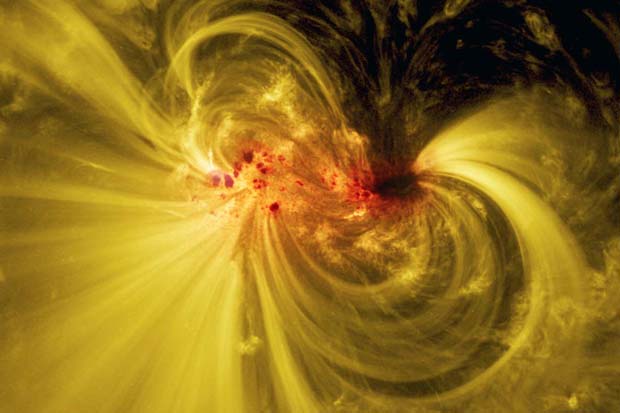A gorgeous new video shows a giant sunspot rotating across the sun's face, firing off flares and an eruption of superhot plasma known as a coronal mass ejection (CME).
NASA's Solar Dynamics Observatory (SDO) and the NASA-European Space Agency Solar and Heliospheric Observatory (SOHO) tracked the sunspot, known as AR 12665, for nearly two weeks, from July 5 through July 17.
Sunspots, also known as active regions, are dark patches with slightly lower temperatures than the rest of the solar surface. These features tend to be launchpads for solar storms, as the new video shows.

The satellites saw two flares — outbursts of high-energy light — blast from AR 12665, one each on July 9 and July 14. Both were medium-size flares, clocking in at the M1 and M2 levels, respectively. (Scientists classify flares in a three-tiered system: "C" for weak flares, "M" for midlevel ones and "X" for strong ones. There is further subdivision as well; M2 flares are twice as powerful as M1 flares, for example.)
A CME accompanied the July 14 flare, as often happens. This cloud of material rocketed away from the sun at about 2.2 million mph (3.5 million km/h), SOHO's observations revealed. The CME reached Earth on July 16, sparking ramped-up aurora displays on the planet, NASA officials said.
AR 12665 was one of the only blemishes on the sun's face during the period covered by the video. This isn't surprising, because Earth's star is in a bit of a lull at the moment. Indeed, the sun is moving toward solar minimum, the low point in the star's 11-year activity cycle, NASA officials said.
The $800 million SDO mission launched in February 2010. SOHO is even longer-lived; the spacecraft took to the skies in December 1995.
Get the Space.com Newsletter
Breaking space news, the latest updates on rocket launches, skywatching events and more!
Note: Space.com Senior Producer Steve Spaleta contributed to this report.
Follow Mike Wall on Twitter @michaeldwall and Google+. Follow us @Spacedotcom, Facebook or Google+. Originally published on Space.com.
Join our Space Forums to keep talking space on the latest missions, night sky and more! And if you have a news tip, correction or comment, let us know at: community@space.com.

Michael Wall is a Senior Space Writer with Space.com and joined the team in 2010. He primarily covers exoplanets, spaceflight and military space, but has been known to dabble in the space art beat. His book about the search for alien life, "Out There," was published on Nov. 13, 2018. Before becoming a science writer, Michael worked as a herpetologist and wildlife biologist. He has a Ph.D. in evolutionary biology from the University of Sydney, Australia, a bachelor's degree from the University of Arizona, and a graduate certificate in science writing from the University of California, Santa Cruz. To find out what his latest project is, you can follow Michael on Twitter.









